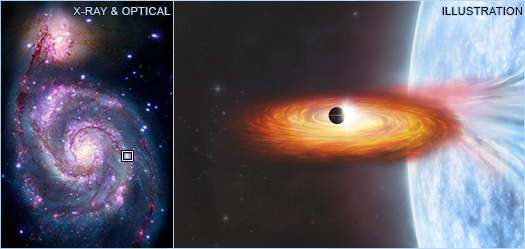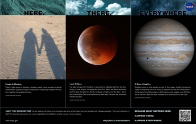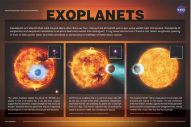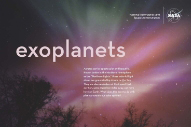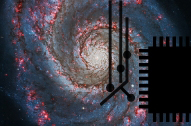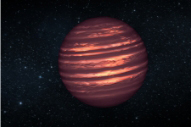News
CHANDRA SEES EVIDENCE FOR POSSIBLE PLANET IN ANOTHER GALAXY
Astronomers have found evidence for a possible planet candidate in the M51 (“Whirlpool”) galaxy, potentially representing what would be the first planet detected outside of the Milky Way. Researchers used NASA’s Chandra X-ray Observatory to detect the dimming of X-rays from an “X-ray binary, a system where a Sun-like star is in orbit around a neutron star or black hole. The authors interpret this dimming as being a planet passing in front of the neutron star or black hole.
Chandra Discoveries
X-rays from Distant Worlds: Chandra Exoplanet Discoveries
In the mid-1990s, something revolutionary happened in astronomy: the discovery of planets outside of our Solar System. NASA’s Chandra X-ray Observatory was launched just a few years later in 1999, while the field of “exoplanets” was very new. This meant that Chandra was essentially already built and no one had foreseen that the telescope could or would be used to observe these distant worlds.
Yet, Chandra has proven to be an invaluable tool for scientists investigating planets across the Milky Way galaxy and perhaps even beyond. X-ray telescopes with sharp vision like Chandra can reveal unique information about an exoplanet, including about what powers them and how they interact with their environment and host star. When combined with data from visible light and other telescopes, Chandra observations provide scientists with a more comprehensive view of exoplanets than would otherwise be possible.
Some of Chandra's contributions to the study of exoplanets include: examples of planets under assault by outside forces like radiation from the host star, powerful gravity of a white dwarf ripping a planet apart, or a star devouring a young planet. Chandra data were also used to show that young stars can unleash a torrent of X-ray radiation that may significantly shorten the lifetime of planet-forming disks surrounding these stars. These valuable X-ray data also have shown that the planet can affect the host star itself, causing stellar aging beyond its actual years.
The Basics
What is an exoplanet?
An exoplanet is any planet beyond our Solar System. Most orbit other stars, but free-floating exoplanets, called rogue planets, orbit the Galactic Center and are untethered to any star.
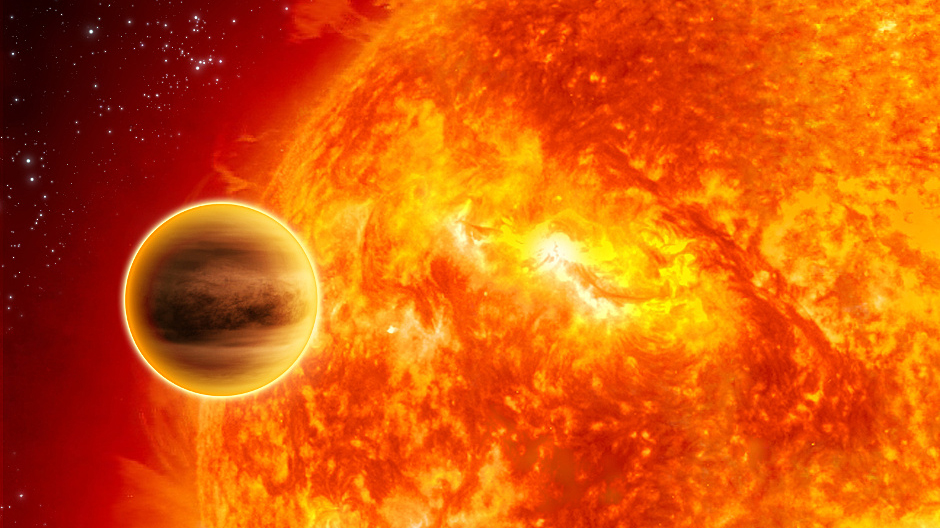
51 Pegasi b is about half the size of Jupiter and orbits its star in about four days. 51 Peg helped launch a whole new field of exploration.
Illustration: NASA/JPL-Caltech
Overview
Most of the exoplanets discovered so far are in a relatively small region of our Milky Way galaxy. By measuring the size and mass of exoplanets, scientist can determine their compositions. These range from very rocky (like Earth and Venus) to very gas-rich (like Jupiter and Saturn). Exoplanets are made up of elements similar to those of the planets in our Solar System, but the mixtures of those elements may differ. For example, some planets may be dominated by water or ice, while others are dominated by iron or carbon. Astronomers have identified lava worlds covered in molten seas, puffy planets the density lighter than Styrofoam, and dense cores of planets still orbing their stars.
The first exoplanets were discovered in the 1990s and since then astronomers have identified thousands using a variety of detection methods. This ever-rising exoplanet tally comes from only a small sampling of the whole Galaxy, and will certainly increase as new telescopes and observatories come online.
To date, most exoplanets have been found through indirect methods: measuring the dimming of a star that happens to have a planet pass in front of it (called a “transit”), or monitoring the light of a star for minute Doppler shift variations caused by the tug of planet.
When scientists are able to use multiple methods together, they can learn the vital statistics of whole planetary systems – without ever directly imaging the planets themselves. The best example so far is the TRAPPIST-1 system about 40 light-years away, where seven roughly Earth-sized planets orbit a small, red star.
The TRAPPIST-1 planets have been examined with ground and space telescopes. The space-based studies revealed not only their diameters, but the subtle gravitational influence these seven closely packed planets have upon each other; from this, scientists determined each planet’s mass.
By combining this information with how much energy the host star the energy, scientists were able to estimate the temperatures on these seven planets’ surfaces. They can even make reasonable estimates of the light level and guess at the color of the sky, if someone were standing on one of them. And while much remains unknown about these seven worlds, including whether they possess atmospheres or oceans, ice sheets or glaciers, it’s become the best-known Solar System apart from our own.
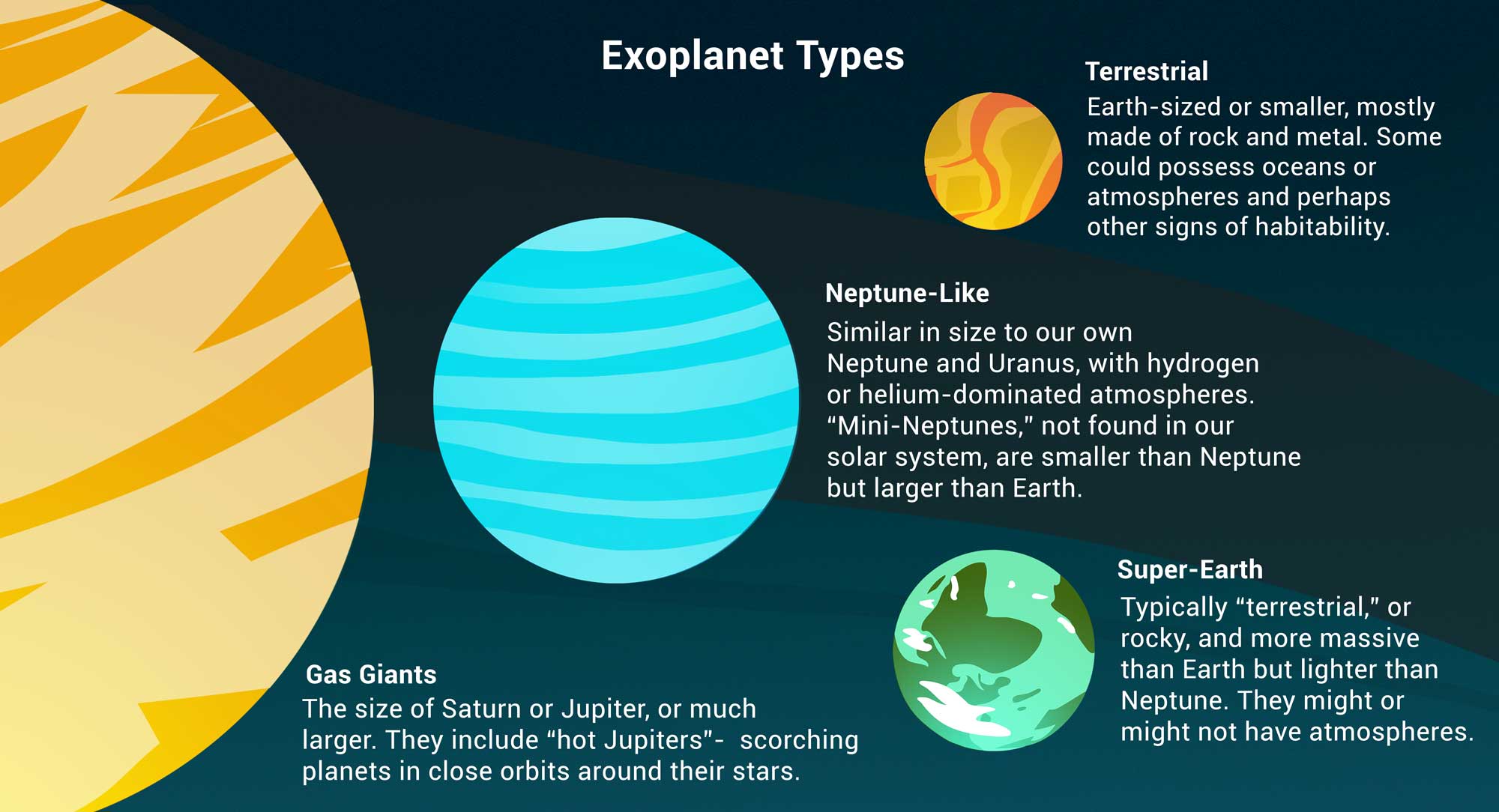
Types of Exoplanets
Each planet type varies in interior and exterior appearance depending on composition:
Gas giants are planets the size of Saturn or Jupiter, the largest planet in our Solar System, or much, much larger. More variety is hidden within these broad categories. Hot Jupiters, for instance, were among the first planet types found – gas giants orbiting so closely to their stars that their temperatures soar into the thousands of degrees (Fahrenheit or Celsius).
Neptunian planets are similar in size to Neptune or Uranus in our Solar System. They likely have a mixture of interior compositions, but all will have hydrogen and helium-dominated outer atmospheres and rocky cores. We’re also discovering mini-Neptunes, planets smaller than Neptune and bigger than Earth. No planets of this size or type exist in our Solar System.
Super-Earths are typically terrestrial planets that may or may not have atmospheres. They are more massive than Earth, but lighter than Neptune.
Terrestrial planets are Earth sized and smaller, composed of rock, silicate, water or carbon. Further investigation will determine whether some of them possess atmospheres, oceans or other signs of habitability.
HOW EXOPLANETS CAN BE DISCOVERED WITH X-ray light
Looking for the dimming of a star’s light as something passes in front of it is called the transit technique. For years, scientists have discovered exoplanets using transits with optical light telescopes, which detect the range of light humans can see with their eyes and more. This includes both ground-based telescopes and space-based ones like NASA’s Kepler mission. These optical light transit detections require very high levels of sensitivity because the planet is much smaller than the star it passes in front of, and, therefore, only a tiny fraction of the light is blocked (see video, at right).
The scenario of a transit in an X-ray binary is different. Because a potential planet is close in size to the X-ray source around the neutron star or black hole, a transiting planet passing along Earth’s line of sight could temporarily block most or all of the X-rays (see the second video, at right. This makes it possible to spot transits at greater distances – including beyond the Milky Way -- than current optical light studies using transits.
To learn more about some of the other ways to find a planet, visit the NASA exoplanet page: https://exoplanets.nasa.gov/alien-worlds/ways-to-find-a-planet/
Credit: NASA
Credit: NASA/CXC/A.Jubett




